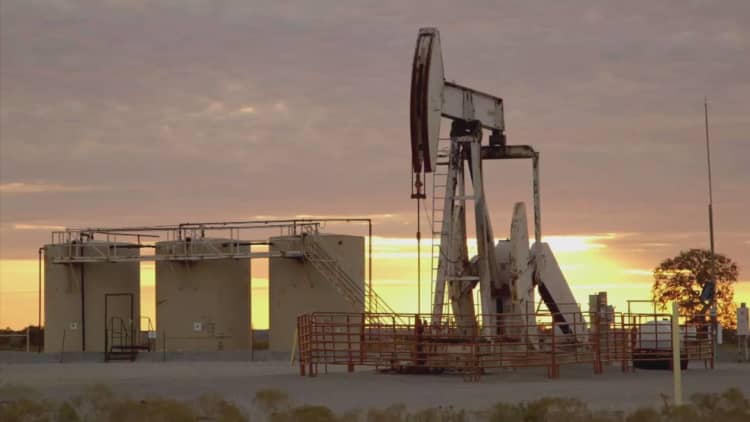
Brent crude oil hit a new 2017 high on Monday, continuing a rally fueled by improving demand and expectations that producers will extend output cuts.
U.S. West Texas Intermediate crude surged more $1.56, or 3.1 percent, to end Monday's session at $52.22 a barrel, the highest closing level since April. WTI hit a session peak of $52.28, about $3 below its 2017 intraday high.
International benchmark rose $2.01, or 3.5 percent, to $58.87 by 2:09 p.m. ET, having touched the highest level since July, 2015.
U.S. WTI crude futures, year to date, source: Factset
Trader positioning shows the market believes there's more room for U.S. crude prices to run up.
Hedge funds raised their bullish bets on U.S. crude futures to the highest level in four weeks, the U.S. Commodity Futures Trading Commission reported on Friday. Wagers that oil prices will fall declined for a third straight week, according to the data covering trades through Sept. 19.
The positioning suggests that the prevailing bear case in the market is unraveling, said Tamar Essner, director of energy and utilities at Nasdaq Corporate Solutions. Traders were convinced that U.S. drillers would flood the market with oil whenever prices rose above $50 a barrel.
But American producers signaled a greater focus on fiscal discipline during second quarter earnings reports.
"It's not profitable to grow at $50. They can [grow], but their investors don't want them to anymore," Essner said, noting that energy stocks have lagged the broader market. "Investors are no longer really willing to foot the bill for that."
Traders also appear to be betting that U.S. crude will rise to close the price gap with international oil prices, rather than Brent falling to narrow the spread, Essner added.
Resurgent production from U.S. shale oil producers, who use advanced drilling methods, has played a major role in delaying the market rebalancing. Higher oil prices this year have encouraged American drillers to pump more, but there are signs the U.S. recovery is slowing.
The number of oil rigs operating in U.S. fields has plateaued recently. A weekly rig count kept by oilfield services firm Baker Hughes fell for the fifth time in six weeks, figures released on Friday showed.
Monthly U.S. oil production figures released earlier this month showed American output ticked down slightly in June to about 9.1 million barrels a day. Preliminary weekly figures show production at roughly 9.5 million barrels a day in the week through Sept. 15, recovering after a brief dip due to impacts from Hurricane Harvey.

OPEC and other oil exporters declined on Friday to extend their agreement to limit production in a bid to drain a global glut that has weighed on prices for three years. However, some analysts believe it's only a matter of time before the cartel agrees to an extension.
"The market anticipates that OPEC and non-OPEC [exporters] are going to continue with their production cuts through 2018," said Andy Lipow, president of Lipow Oil Associates.
OPEC has now achieved its goal of flipping Brent crude's market structure into so-called backwardation, said Francisco Blanch, head of global commodities and derivatives research at Bank of America Merrill Lynch.
In backwardation, prices for future delivery are cheaper than the cost of oil for immediate shipment. Backwardation signals the market is tightening and discourages oil traders from stockpiling barrels.
However, analysts warned that exporters whose budgets are dependent on oil revenues will be tempted to pump above agreed-upon levels as Brent crude nears $60 a barrel.
"Even at these prices levels, they're still bleeding cash. So they want more money and I think the incentive to stay together starts to decrease," Blanch told CNBC's "Squawk Box" in Asia.
The market is increasingly focused on the demand outlook, after the International Energy Agency and OPEC both raised their forecasts for global oil consumption, analysts tell CNBC.
"In spite of increases from U.S. shale production, that kind of increase is enough to sop up" excess oil supply, Lipow said.


